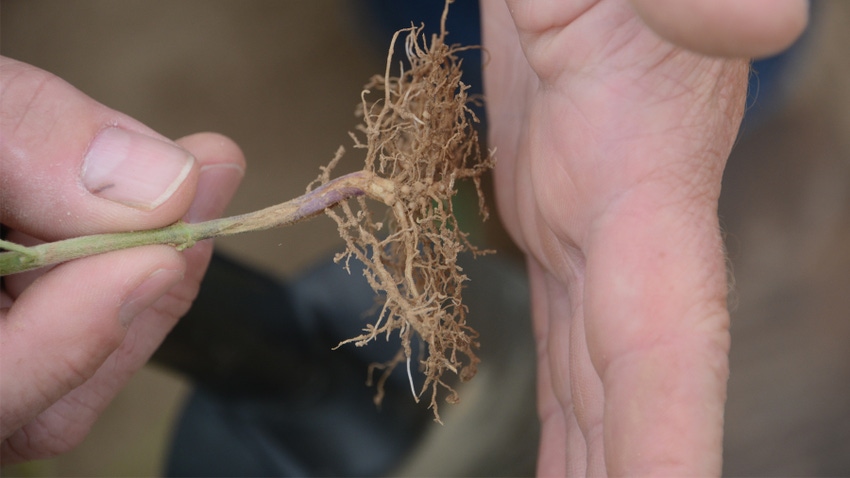
The trowel would only go in an inch. Steve Gauck noticed he was in an area where water likely ran at some time during the year. He was also near the end of the field. Roots of the plant he dug up resembled fibrous roots of a corn plant more than the taproot of a normal soybean plant.
“There were nodules on the roots trying to work, but they were small,” says Gauck, a regional agronomy manager for Beck’s, based near Greensburg, Ind. Beck’s sponsors Soybean Watch ’23. “The bottom of the roots was so flat it looked like they were hitting a brick wall. It was obviously caused by hitting a compacted layer.
“The roots also stubbed off on one side. It’s likely sidewall compaction caused them to stop growing. When a plant encounters this much soil compaction, it will have an effect. The plant may be able to grow out of it to some degree. Part of that will depend on what the rest of the season is like.”
Because this field has irrigation, getting enough water should not be a major limitation. Past research at Purdue and Ohio State universities indicates that adequate moisture for growth, either through irrigation or rainfall, can sometimes mask the effects of soil compaction in soybeans — more so than in corn.
Plant comparison
Only 50 feet away, Gauck dug a second soybean plant. He easily pushed the trowel 3 inches into the soil. “There weren’t obvious signs of soil compaction,” Gauck says. “These plants came from two totally different growing environments.”
Here were the most obvious differences:
Size. Gauck determined the plant growing without soil compaction was at V5, with five sets of trifoliate leaves. The plant from the compacted area was still at V2, stunted by struggling through hard soil.
Root formation. Roots on the normal plant showed the typical taproot shape of a soybean plant. They also extended several inches into the soil.

2 DIFFERENT ENVIRONMENTS: These two plants were growing 50 feet apart, but it looks like they were growing in two very different fields.
Nodule comparison. Nodules on the normal plant were larger and actively working, Gauck reports. They were pink inside, indicating nitrogen was captured from the atmosphere.
Planting depth. Gauck determined planting depth by gauging the soil line on the stem. The plant from the compacted soil was only planted about an inch deep. “The soil was so hard, the planter likely had trouble penetrating and getting the seed where it was supposed to be,” he says. “Soil compaction can affect how equipment performs too.”
Expected outcome. Both plants will likely contribute yield, Gauck says. “The healthier, more advanced plant will likely wind up with more nodes, and more nodes means more beans,” he says. “The plant growing in compacted soil will need more assistance from irrigation if it turns dry again later in the season.”
Read more about:
Soil CompactionAbout the Author(s)
You May Also Like




